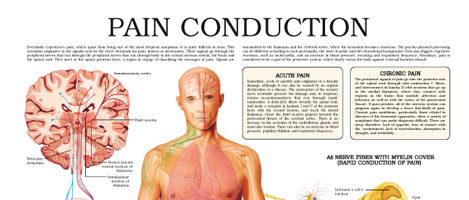
EnglishSpanish
Everybody experiences pain, which apart from being one of the most frequent symptoms, it is quite difficult to treat. This sensation originates in the signals sent by the nerve terminals for pain, known as nociceptors. These signals go through the peripheral nerves that run through the peripheral nerves that run through body to the central nervous system, the brain and
the spinal cord. They meet at the spinal posterior horn, a region in charge of classifying the messages of pain. Signals are transmitted to the thalamus and the cerebral cortex, where the sensation becomes conscious. The psycho-physical processing can be different according to each personality, the state of mind, and the educational background. Pain also triggers vegetative
reactions, such as tachycardia, and an increase in blood pressure, sweating and respiratory frequency. Nowadays, pain is considered to be a part of the protective system, which timely warns the body against external harmful stimuli.
the spinal cord. They meet at the spinal posterior horn, a region in charge of classifying the messages of pain. Signals are transmitted to the thalamus and the cerebral cortex, where the sensation becomes conscious. The psycho-physical processing can be different according to each personality, the state of mind, and the educational background. Pain also triggers vegetative
reactions, such as tachycardia, and an increase in blood pressure, sweating and respiratory frequency. Nowadays, pain is considered to be a part of the protective system, which timely warns the body against external harmful stimuli.
Todas las personas experimentan dolor. Se trata de uno de los síntomas más frecuentes y difíciles de tratar. Esta sensación es debida a las señales que emiten las terminales nerviosas para el dolor, denominadas nociceptores, y que viajan a través de los nervios periféricos que recorren el cuerpo hacia el sistema nervioso central, el cerebro y la médula espinal. Se reúnen en el cuerno posterior medular, una región que actúa clasificando los mensajes del dolor. Las señales se transmiten al tálamo y la corteza cerebral, donde la sensación se hace consciente. El procesamiento psico-físico puede variar según la personalidad, el estado de ánimo y la educación. El dolor provoca también reacciones vegetativas, como la taquicardia, el aumento de la presión arterial, la sudoración y el aumento de la frecuencia respiratoria. El dolor es considerado hoy como una parte del sistema protector, advirtiendo oportunamente al organismo acerca de estímulos nocivos externos.




